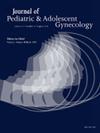12. 青少年雄激素过多:考虑其险恶的原因。青少年颗粒细胞瘤1例报告。
IF 1.7
4区 医学
Q3 OBSTETRICS & GYNECOLOGY
引用次数: 0
摘要
我们提出的情况下,14岁的女孩,转到儿科和青少年妇科服务的评估和管理雄激素过多。骨盆超声示13cm附件囊肿。患者接受了右侧输卵管卵巢切除术。组织学证实为幼年颗粒细胞瘤。本病例强调了在评估雄激素过多(包括恶性肿瘤)时考虑广泛鉴别诊断的重要性。病例:本例患者有青春期发育不一致的病史;Tanner: 1期乳房发育,出现明显多毛,影响面部、胸部、下腹部和大腿内侧。骨盆超声及MRI示大附件囊肿,尺寸11.4 × 4 × 7.4cm。胸片和肾上腺超声检查均正常。睾酮中度升高,为2.7nmol/L(0.22-1.7)。核型为46XX。该患者术前在妇科肿瘤科进行了讨论。青少年患者雄激素过多的鉴别诊断包括多囊卵巢综合征、迟发性先天性肾上腺增生和卵巢或肾上腺分泌雄激素的肿瘤。手术发现约20cm的右侧卵巢囊肿伴实性成分,患者行右侧输卵管卵巢切除术,并发术中囊肿内容物外溢。组织学显示为幼年颗粒细胞瘤。然后她进行了分期,包括CT TAP和完成手术,包括淋巴结取样,网膜切除术和阑尾切除术。这证实了FIGO 1C1期恶性肿瘤,患者接受了三个周期的卡铂紫杉醇辅助化疗。这个病例强调了考虑恶性肿瘤的重要性,在鉴别诊断的青少年患者表现为高雄激素。本文章由计算机程序翻译,如有差异,请以英文原文为准。
12. Adolescent Hyperandrogenism: Consider The Sinister Cause. A Case Report Of A Juvenile Granulosa Cell Tumour.
Background
We present the case of a 14 year old girl, referred to the Paediatric and Adolescent Gynaecology service for the assessment and management of hyperandrogenism. Ultrasound Pelvis revealed a 13cm adnexal cyst. The patient underwent a right salpingo-oophorectomy. Histology confirmed a juvenile granulosa cell tumour. This case underscores the importance of consideration of a broad differential diagnosis in the assessment of hyperandrogenism, including malignancy.
Case
Our patient presented with a history of incongruent pubertal development; Tanner Stage 1 breast development, in the setting of significant hirsutism, affecting the face, chest, lower abdomen, and inner thigh. US and MRI Pelvis were carried out, and showed a large adnexal cyst, measuring 11.4 × 4 × 7.4cm. Chest x-ray and adrenal US were both carried out and were normal. Testosterone was moderately elevated at 2.7nmol/L (0.22-1.7). Karyotype was 46XX. This patient's case was discussed pre-operatively at a Gynaecology Oncology MDT
Comments
The differential diagnosis for hyperandrogenism in the adolescent patient includes Polycystic Ovarian Syndrome, late-onset Congenital Adrenal Hyperplasia, and androgen-secreting tumours of the ovary or adrenal gland. Surgical findings were of an approximately 20cm right ovarian cyst with a solid component, and the patient underwent a right-salpingoophorectomy, complicated by intra-operative spillage of cyst contents. Histology revealed a juvenile granulosa cell tumour. She then had staging, including a CT TAP and completion surgery, including lymph node sampling, omentectomy, and appendicectomy. This confirmed a FIGO Stage 1C1 malignancy, and the patient received three cycles of Carboplatin Paclitaxal adjuvant chemotherapy. This case highlights the importance of considering malignancy in the differential diagnosis of an adolescent patient presenting with hyperandrogenism.
求助全文
通过发布文献求助,成功后即可免费获取论文全文。
去求助
来源期刊
CiteScore
3.90
自引率
11.10%
发文量
251
审稿时长
57 days
期刊介绍:
Journal of Pediatric and Adolescent Gynecology includes all aspects of clinical and basic science research in pediatric and adolescent gynecology. The Journal draws on expertise from a variety of disciplines including pediatrics, obstetrics and gynecology, reproduction and gynecology, reproductive and pediatric endocrinology, genetics, and molecular biology.
The Journal of Pediatric and Adolescent Gynecology features original studies, review articles, book and literature reviews, letters to the editor, and communications in brief. It is an essential resource for the libraries of OB/GYN specialists, as well as pediatricians and primary care physicians.

 求助内容:
求助内容: 应助结果提醒方式:
应助结果提醒方式:


